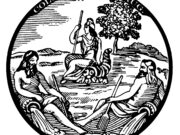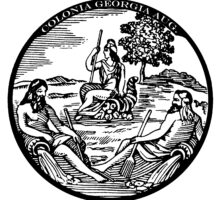Henry Ellis, the second royal governor of Georgia, has been called “Georgia’s second founder.” Georgia had no self-government under the Trustees (1732-52), and the first royal governor, John Reynolds (1754-57), failed as an administrator. Under the leadership of Ellis (1757-60) Georgians learned how to govern themselves, and they have been doing so ever since.
As a teenager Ellis left his irascible father in Monaghan County, Ireland, to take to the sea. Gifted with intelligence and ability, Ellis learned the science of navigation and the art of mapmaking, and at the age of twenty-five was offered the position of scientific observer on a ship bound for Hudson’s Bay in a search for the Northwest Passage. His subsequent book about the voyage and his maps earned for him an audience with Frederick, Prince of Wales; the patronage of Lord Halifax, president of the Board of Trade; and membership in the prestigious Royal Society. He went to sea again as the captain of the trading vessel Earl of Halifax and carried out a series of experiments for members of the Royal Society.
From 1750 until 1755 Ellis carried cargoes of enslaved Africans to Jamaica. He negotiated with African chieftains for the purchase of those who had already lost their freedom because of war, crime, or debt. Unlike some practitioners of the terrible trade, he exercised enslaved captives on deck and fumigated their quarters below deck. He made three voyages from England to Africa and Jamaica. He reported that none of the 312 enslaved persons he carried in 1754 died on the passage from Africa.
As head of the Board of Trade, Lord Halifax hoped to make Georgia a model colony. A chorus of complaints from Georgia about Governor Reynolds caused Halifax to remove Reynolds and send Ellis in his place. Georgians greeted Ellis with enthusiasm when he arrived in February 1757. With tact he quieted the vicious factionalism that had wracked the Reynolds administration and guided the members of the legislature in the rudiments of government. In 1758 he sponsored legislation that divided the province into eight parishes, each with delegates to the assembly.
Realizing the weakness of Georgia in the ongoing war against the French and French-allied Indians, Ellis cultivated the friendship of the heads of the Creek Nation. He settled the claims of Mary Musgrove, long a source of irritation between Georgians and the Creeks. He worked with influential traders like Lachlan McGillivray and George Galphin to preserve the neutrality of the numerous Creek towns during the war against the Cherokees in the winter of 1759-60. Some Creek warriors even helped defend Georgia against the Cherokees.
Poor health forced Ellis to leave Georgia in November 1760. He stopped in New York to confer with General Jeffrey Amherst to request military assistance for the southern colonies. Lord Halifax rewarded him with the governorship of Nova Scotia. Ellis never went to that province, however, because his presence was needed in London. Lord Egremont, who replaced William Pitt as the cabinet minister for America, relied on Ellis for information and advice on American affairs. As a result Ellis played a key role in formulating American policy.
Ellis planned the successful British conquest of Cuba. He advised giving Cuba back to Spain in exchange for Florida in the peace settlement, thus removing a Spanish threat from Georgia’s borders. Ellis was responsible for the order summoning four royal governors to Augusta to conclude a treaty with the Creeks in 1763 and wrote a draft of the historic royal proclamation of 1763 that transformed British North America. The proclamation established governments modeled after Georgia’s in East and West Florida, Canada, and Nova Scotia. It drew a line down the Appalachian mountain range, forbidding settlement to the west of the mountains, to protect Indian lands and trade. The proclamation benefited Georgia by extending its boundaries to the St. Marys River in the South and the Mississippi River in the West.
Ellis was rewarded for his services by receiving several lucrative government positions guaranteeing a comfortable future. After Egremont’s death in 1763 and a change in administrations, Ellis entered retirement as a gentleman of the Enlightenment. He died in Naples, Italy, in 1806, at age eighty-five.






